Jiye Liang
Progressive Local Alignment for Medical Multimodal Pre-training
Feb 25, 2025Abstract:Local alignment between medical images and text is essential for accurate diagnosis, though it remains challenging due to the absence of natural local pairings and the limitations of rigid region recognition methods. Traditional approaches rely on hard boundaries, which introduce uncertainty, whereas medical imaging demands flexible soft region recognition to handle irregular structures. To overcome these challenges, we propose the Progressive Local Alignment Network (PLAN), which designs a novel contrastive learning-based approach for local alignment to establish meaningful word-pixel relationships and introduces a progressive learning strategy to iteratively refine these relationships, enhancing alignment precision and robustness. By combining these techniques, PLAN effectively improves soft region recognition while suppressing noise interference. Extensive experiments on multiple medical datasets demonstrate that PLAN surpasses state-of-the-art methods in phrase grounding, image-text retrieval, object detection, and zero-shot classification, setting a new benchmark for medical image-text alignment.
C-LoRA: Continual Low-Rank Adaptation for Pre-trained Models
Feb 25, 2025Abstract:Low-Rank Adaptation (LoRA) is an efficient fine-tuning method that has been extensively applied in areas such as natural language processing and computer vision. Existing LoRA fine-tuning approaches excel in static environments but struggle in dynamic learning due to reliance on multiple adapter modules, increasing overhead and complicating inference. We propose Continual Low-Rank Adaptation (C-LoRA), a novel extension of LoRA for continual learning. C-LoRA uses a learnable routing matrix to dynamically manage parameter updates across tasks, ensuring efficient reuse of learned subspaces while enforcing orthogonality to minimize interference and forgetting. Unlike existing approaches that require separate adapters for each task, C-LoRA enables a integrated approach for task adaptation, achieving both scalability and parameter efficiency in sequential learning scenarios. C-LoRA achieves state-of-the-art accuracy and parameter efficiency on benchmarks while providing theoretical insights into its routing matrix's role in retaining and transferring knowledge, establishing a scalable framework for continual learning.
GNN-Transformer Cooperative Architecture for Trustworthy Graph Contrastive Learning
Dec 24, 2024



Abstract:Graph contrastive learning (GCL) has become a hot topic in the field of graph representation learning. In contrast to traditional supervised learning relying on a large number of labels, GCL exploits augmentation strategies to generate multiple views and positive/negative pairs, both of which greatly influence the performance. Unfortunately, commonly used random augmentations may disturb the underlying semantics of graphs. Moreover, traditional GNNs, a type of widely employed encoders in GCL, are inevitably confronted with over-smoothing and over-squashing problems. To address these issues, we propose GNN-Transformer Cooperative Architecture for Trustworthy Graph Contrastive Learning (GTCA), which inherits the advantages of both GNN and Transformer, incorporating graph topology to obtain comprehensive graph representations. Theoretical analysis verifies the trustworthiness of the proposed method. Extensive experiments on benchmark datasets demonstrate state-of-the-art empirical performance.
Towards Effective Graph Rationalization via Boosting Environment Diversity
Dec 17, 2024



Abstract:Graph Neural Networks (GNNs) perform effectively when training and testing graphs are drawn from the same distribution, but struggle to generalize well in the face of distribution shifts. To address this issue, existing mainstreaming graph rationalization methods first identify rationale and environment subgraphs from input graphs, and then diversify training distributions by augmenting the environment subgraphs. However, these methods merely combine the learned rationale subgraphs with environment subgraphs in the representation space to produce augmentation samples, failing to produce sufficiently diverse distributions. Thus, in this paper, we propose to achieve an effective Graph Rationalization by Boosting Environmental diversity, a GRBE approach that generates the augmented samples in the original graph space to improve the diversity of the environment subgraph. Firstly, to ensure the effectiveness of augmentation samples, we propose a precise rationale subgraph extraction strategy in GRBE to refine the rationale subgraph learning process in the original graph space. Secondly, to ensure the diversity of augmented samples, we propose an environment diversity augmentation strategy in GRBE that mixes the environment subgraphs of different graphs in the original graph space and then combines the new environment subgraphs with rationale subgraphs to generate augmented graphs. The average improvements of 7.65% and 6.11% in rationalization and classification performance on benchmark datasets demonstrate the superiority of GRBE over state-of-the-art approaches.
Graph External Attention Enhanced Transformer
Jun 03, 2024Abstract:The Transformer architecture has recently gained considerable attention in the field of graph representation learning, as it naturally overcomes several limitations of Graph Neural Networks (GNNs) with customized attention mechanisms or positional and structural encodings. Despite making some progress, existing works tend to overlook external information of graphs, specifically the correlation between graphs. Intuitively, graphs with similar structures should have similar representations. Therefore, we propose Graph External Attention (GEA) -- a novel attention mechanism that leverages multiple external node/edge key-value units to capture inter-graph correlations implicitly. On this basis, we design an effective architecture called Graph External Attention Enhanced Transformer (GEAET), which integrates local structure and global interaction information for more comprehensive graph representations. Extensive experiments on benchmark datasets demonstrate that GEAET achieves state-of-the-art empirical performance. The source code is available for reproducibility at: https://github.com/icm1018/GEAET.
PipeOptim: Ensuring Effective 1F1B Schedule with Optimizer-Dependent Weight Prediction
Dec 05, 2023Abstract:Asynchronous pipeline model parallelism with a "1F1B" (one forward, one backward) schedule generates little bubble overhead and always provides quite a high throughput. However, the "1F1B" schedule inevitably leads to weight inconsistency and weight staleness issues due to the cross-training of different mini-batches across GPUs. To simultaneously address these two problems, in this paper, we propose an optimizer-dependent weight prediction strategy (a.k.a PipeOptim) for asynchronous pipeline training. The key insight of our proposal is that we employ a weight prediction strategy in the forward pass to ensure that each mini-batch uses consistent and staleness-free weights to compute the forward pass. To be concrete, we first construct the weight prediction scheme based on the update rule of the used optimizer when training the deep neural network models. Then throughout the "1F1B" pipelined training, each mini-batch is mandated to execute weight prediction ahead of the forward pass, subsequently employing the predicted weights to perform the forward pass. As a result, PipeOptim 1) inherits the advantage of the "1F1B" schedule and generates pretty high throughput, and 2) can ensure effective parameter learning regardless of the type of the used optimizer. To verify the effectiveness of our proposal, we conducted extensive experimental evaluations using eight different deep-learning models spanning three machine-learning tasks including image classification, sentiment analysis, and machine translation. The experiment results demonstrate that PipeOptim outperforms the popular pipelined approaches including GPipe, PipeDream, PipeDream-2BW, and SpecTrain. The code of PipeOptim can be accessible at https://github.com/guanleics/PipeOptim.
Towards Privacy-Aware Causal Structure Learning in Federated Setting
Nov 13, 2022



Abstract:Causal structure learning has been extensively studied and widely used in machine learning and various applications. To achieve an ideal performance, existing causal structure learning algorithms often need to centralize a large amount of data from multiple data sources. However, in the privacy-preserving setting, it is impossible to centralize data from all sources and put them together as a single dataset. To preserve data privacy, federated learning as a new learning paradigm has attached much attention in machine learning in recent years. In this paper, we study a privacy-aware causal structure learning problem in the federated setting and propose a novel Federated PC (FedPC) algorithm with two new strategies for preserving data privacy without centralizing data. Specifically, we first propose a novel layer-wise aggregation strategy for a seamless adaptation of the PC algorithm into the federated learning paradigm for federated skeleton learning, then we design an effective strategy for learning consistent separation sets for federated edge orientation. The extensive experiments validate that FedPC is effective for causal structure learning in federated learning setting.
Sparse Regularized Correlation Filter for UAV Object Tracking with adaptive Contextual Learning and Keyfilter Selection
May 07, 2022



Abstract:Recently, correlation filter has been widely applied in unmanned aerial vehicle (UAV) tracking due to its high frame rates, robustness and low calculation resources. However, it is fragile because of two inherent defects, i.e, boundary effect and filter corruption. Some methods by enlarging the search area can mitigate the boundary effect, yet introducing the undesired background distractors. Another approaches can alleviate the temporal degeneration of learned filters by introducing the temporal regularizer, which depends on the assumption that the filers between consecutive frames should be coherent. In fact, sometimes the filers at the ($t-1$)th frame is vulnerable to heavy occlusion from backgrounds, which causes that the assumption does not hold. To handle them, in this work, we propose a novel $\ell_{1}$ regularization correlation filter with adaptive contextual learning and keyfilter selection for UAV tracking. Firstly, we adaptively detect the positions of effective contextual distractors by the aid of the distribution of local maximum values on the response map of current frame which is generated by using the previous correlation filter model. Next, we eliminate inconsistent labels for the tracked target by removing one on each distractor and develop a new score scheme for each distractor. Then, we can select the keyfilter from the filters pool by finding the maximal similarity between the target at the current frame and the target template corresponding to each filter in the filters pool. Finally, quantitative and qualitative experiments on three authoritative UAV datasets show that the proposed method is superior to the state-of-the-art tracking methods based on correlation filter framework.
Logic could be learned from images
Aug 06, 2019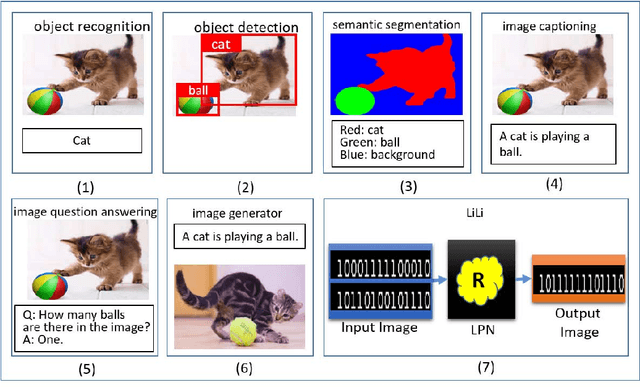
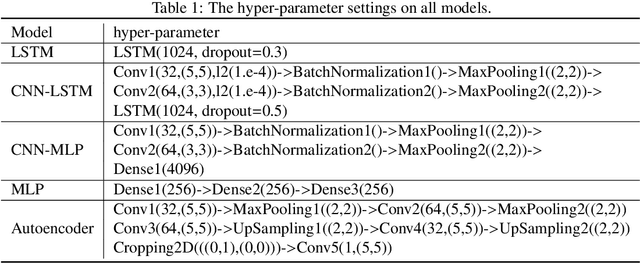
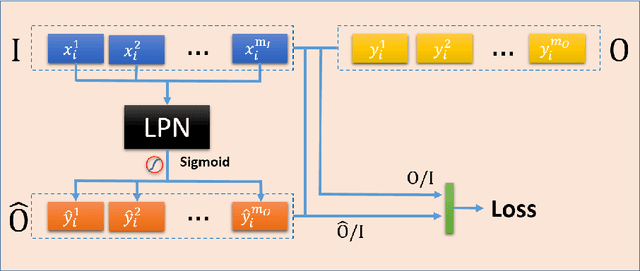
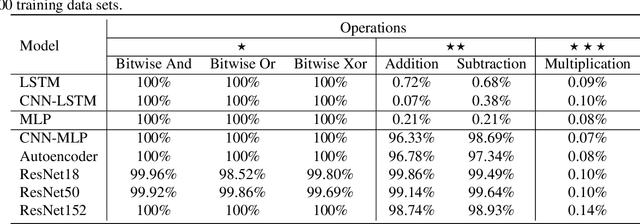
Abstract:Logic reasoning is a significant ability of human intelligence and also an important task in artificial intelligence. The existing logic reasoning methods, quite often, need to design some reasoning patterns beforehand. This has led to an interesting question: can logic reasoning patterns be directly learned from given data? The problem is termed as a data concept logic (DCL). In this study, a learning logic task from images, just a LiLi task, first is proposed. This task is to learn and reason the relation between two input images and one output image, without presetting any reasoning patterns. As a preliminary exploration, we design six LiLi data sets (Bitwise And, Bitwise Or, Bitwise Xor, Addition, Subtraction and Multiplication), in which each image is embedded with a n-digit number. It is worth noting that a learning model beforehand does not know the meaning of the n-digit number embedded in images and relation between the input images and the output image. In order to tackle the task, in this work we use many typical neural network models and produce fruitful results. However, these models have the poor performances on the difficult logic task. For furthermore addressing this task, a novel network framework called a divide and conquer model (DCM) by adding some prior information is designed, achieving a high testing accuracy.
An Ensemble Classification Algorithm Based on Information Entropy for Data Streams
Aug 11, 2017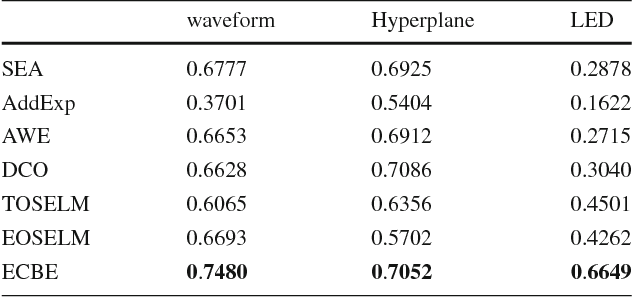
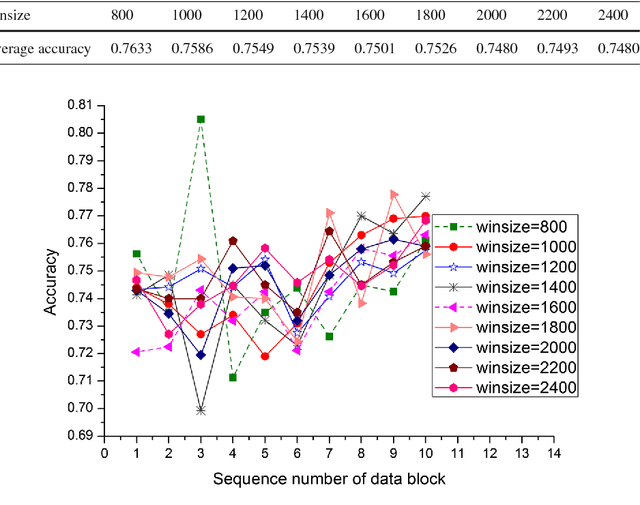
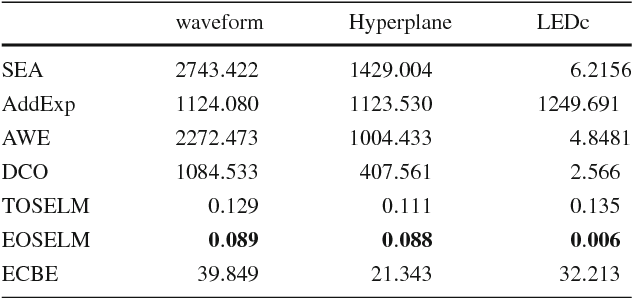
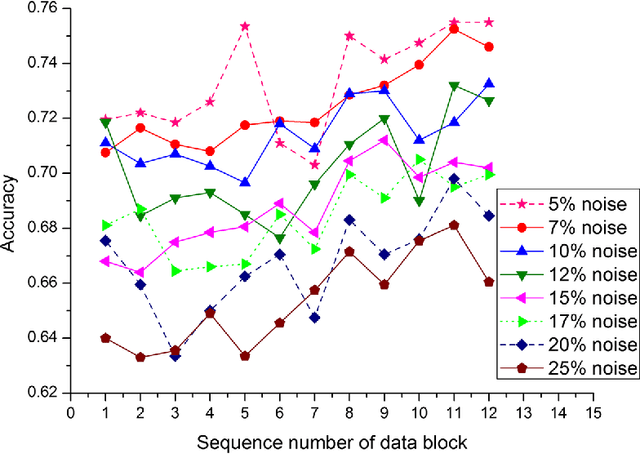
Abstract:Data stream mining problem has caused widely concerns in the area of machine learning and data mining. In some recent studies, ensemble classification has been widely used in concept drift detection, however, most of them regard classification accuracy as a criterion for judging whether concept drift happening or not. Information entropy is an important and effective method for measuring uncertainty. Based on the information entropy theory, a new algorithm using information entropy to evaluate a classification result is developed. It uses ensemble classification techniques, and the weight of each classifier is decided through the entropy of the result produced by an ensemble classifiers system. When the concept in data streams changing, the classifiers' weight below a threshold value will be abandoned to adapt to a new concept in one time. In the experimental analysis section, six databases and four proposed algorithms are executed. The results show that the proposed method can not only handle concept drift effectively, but also have a better classification accuracy and time performance than the contrastive algorithms.
 Add to Chrome
Add to Chrome Add to Firefox
Add to Firefox Add to Edge
Add to Edge